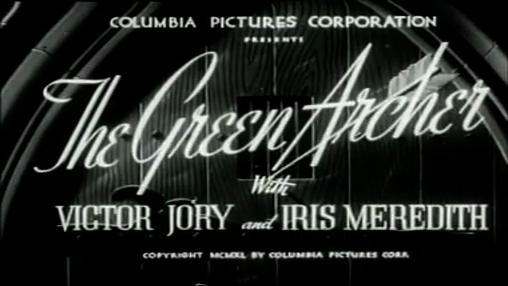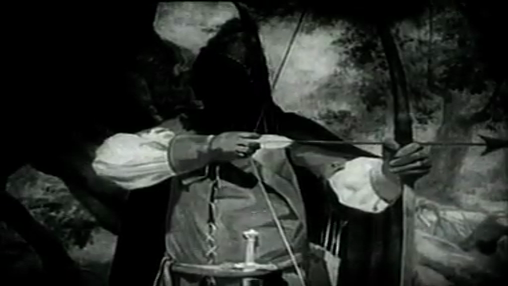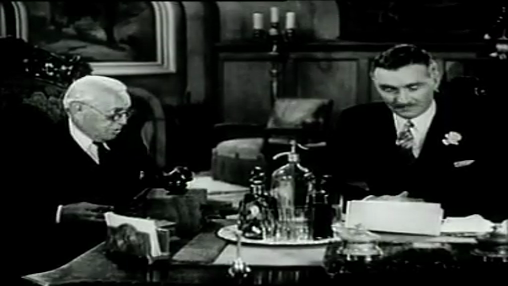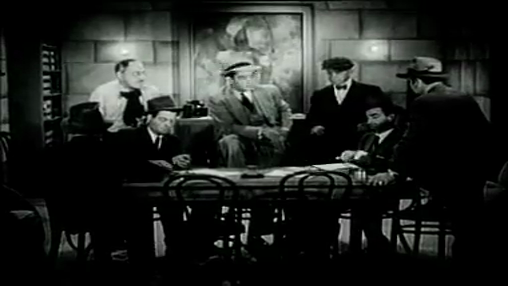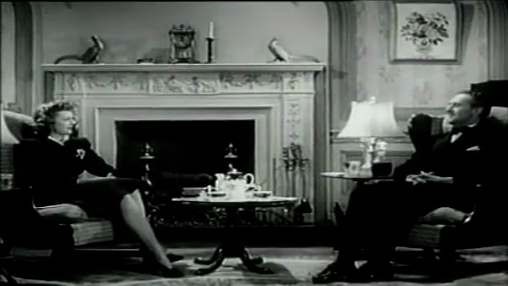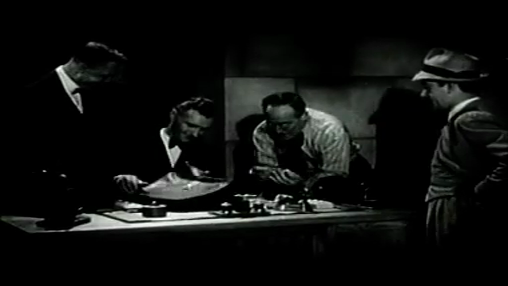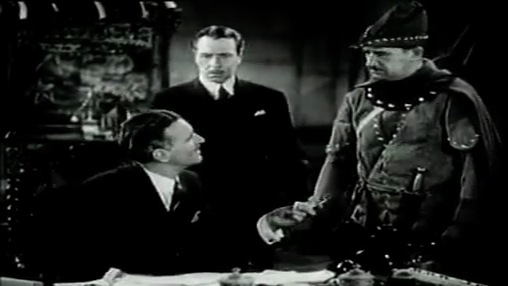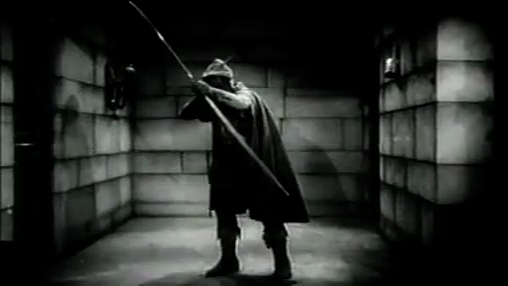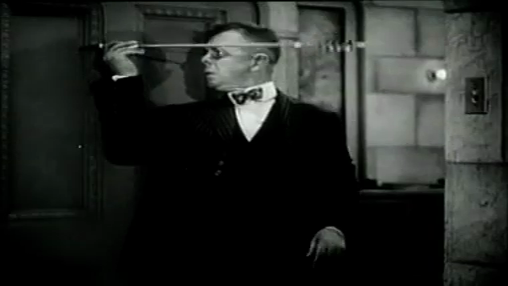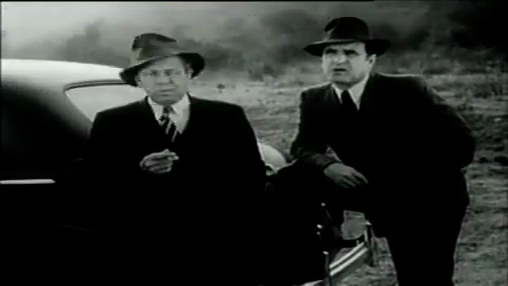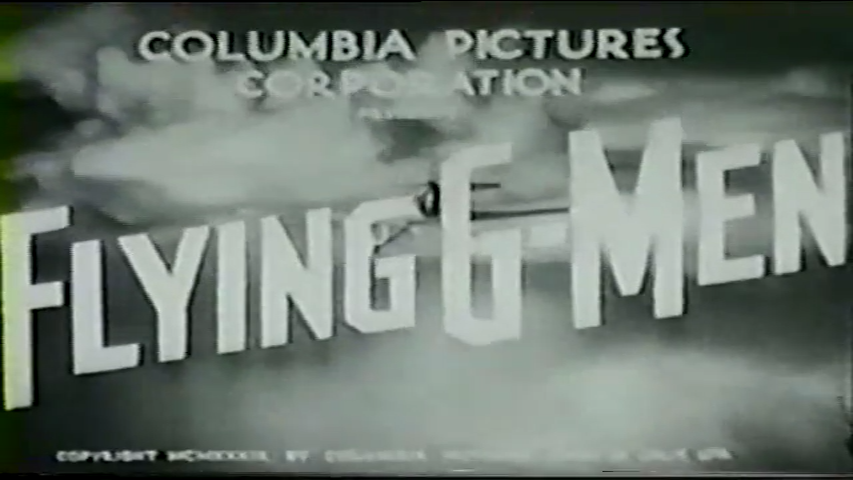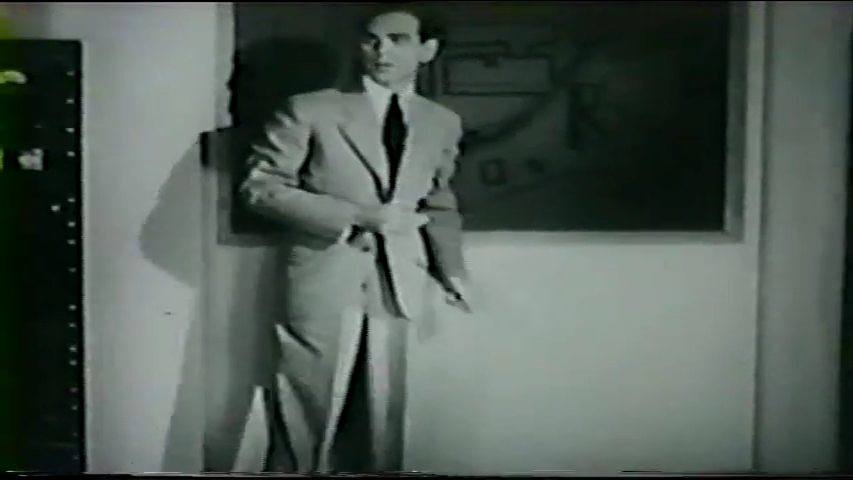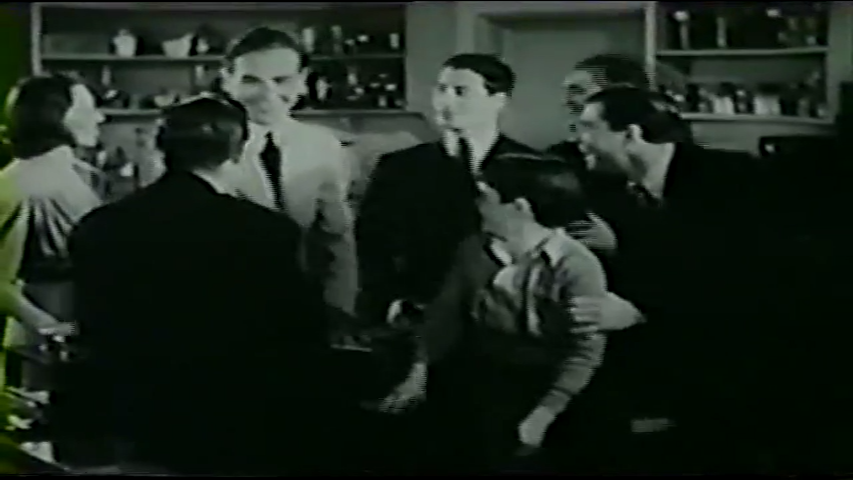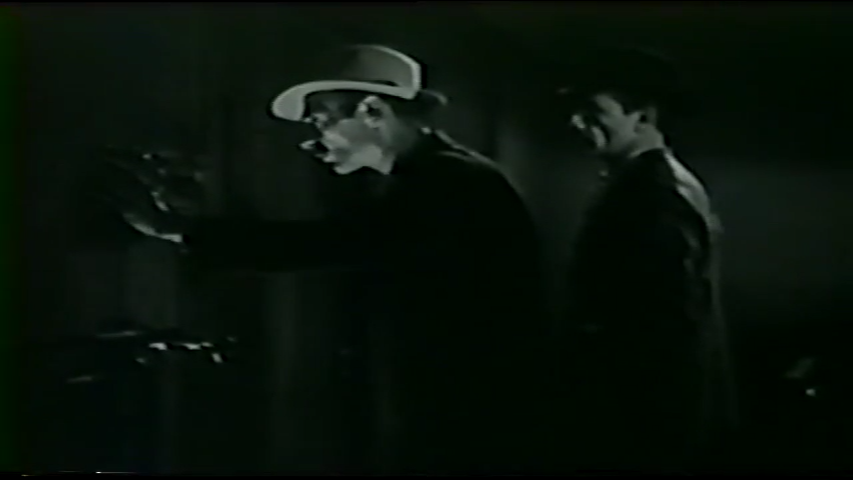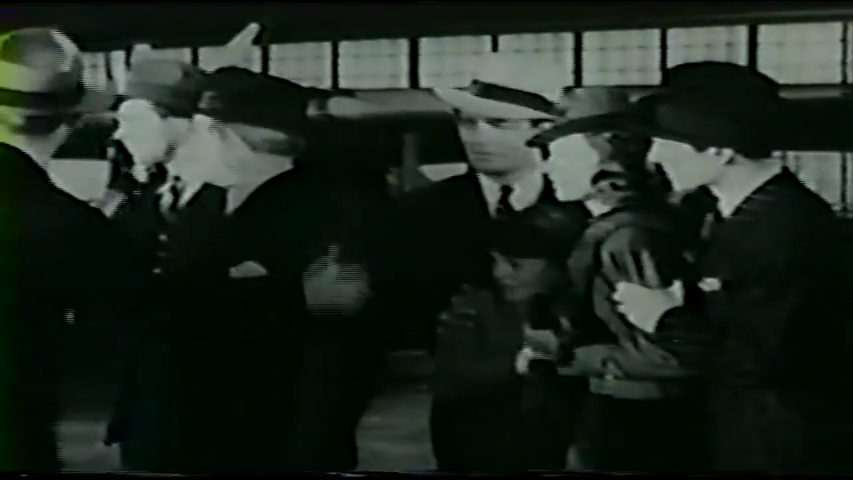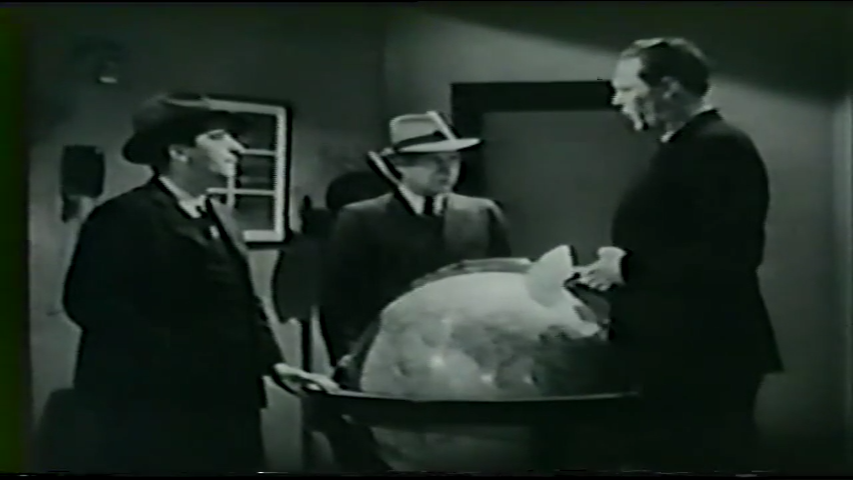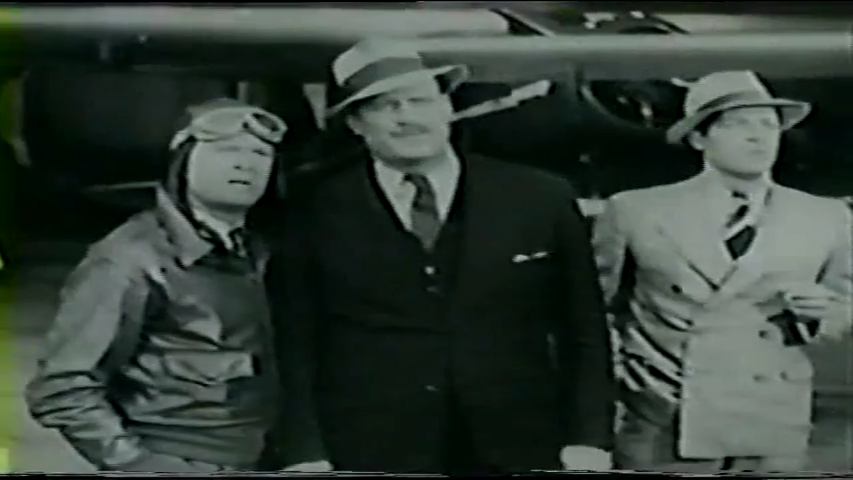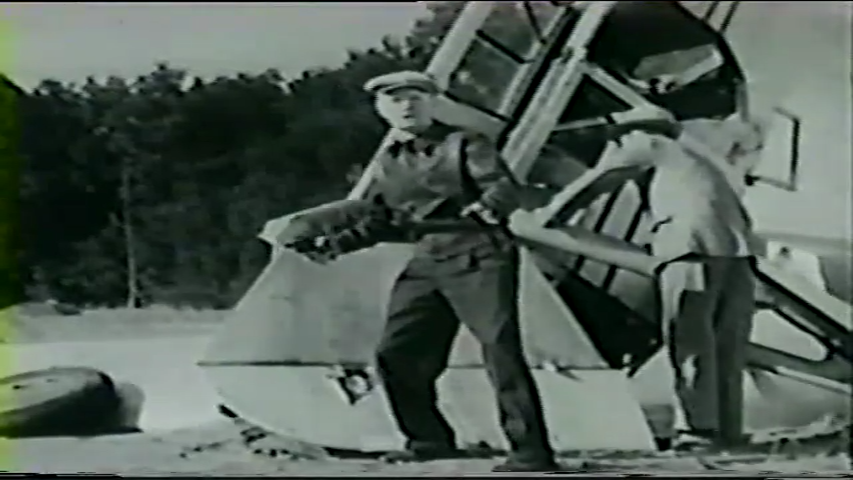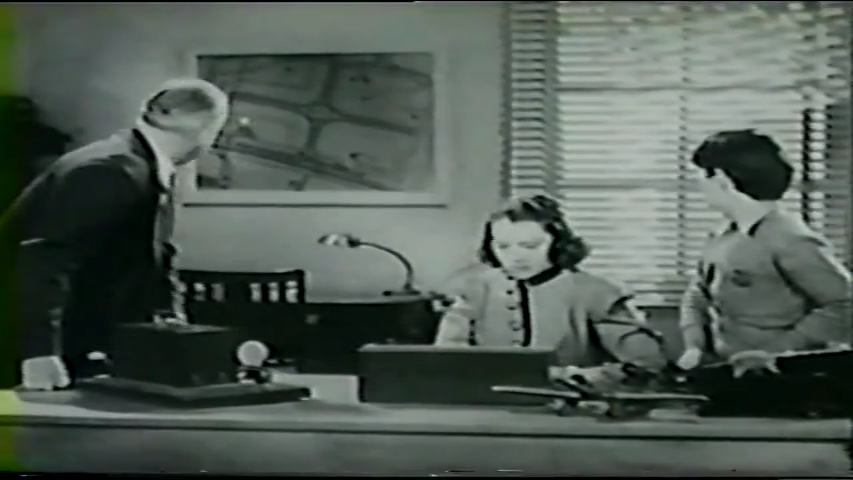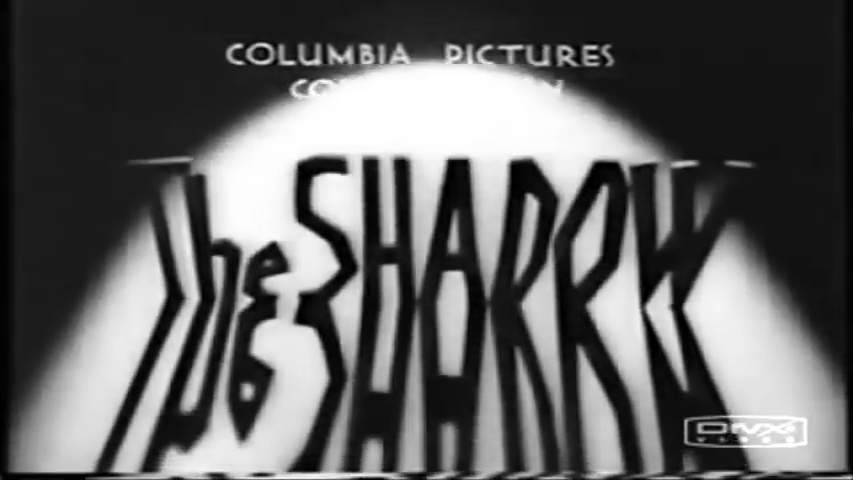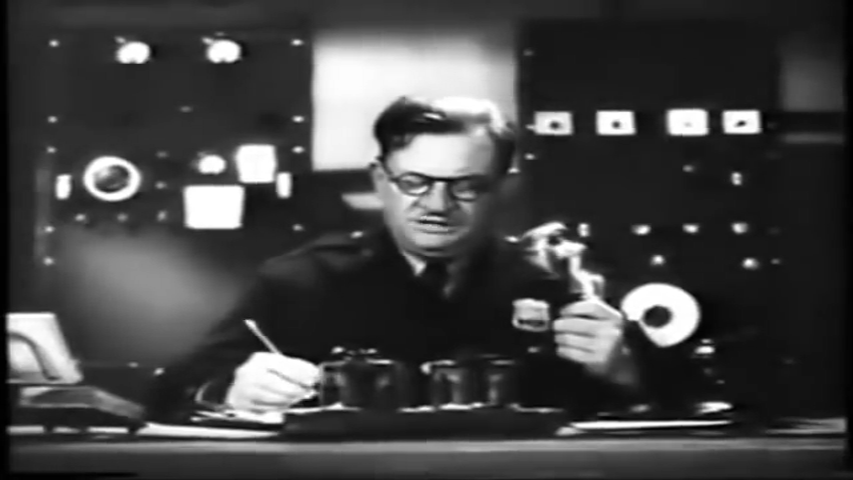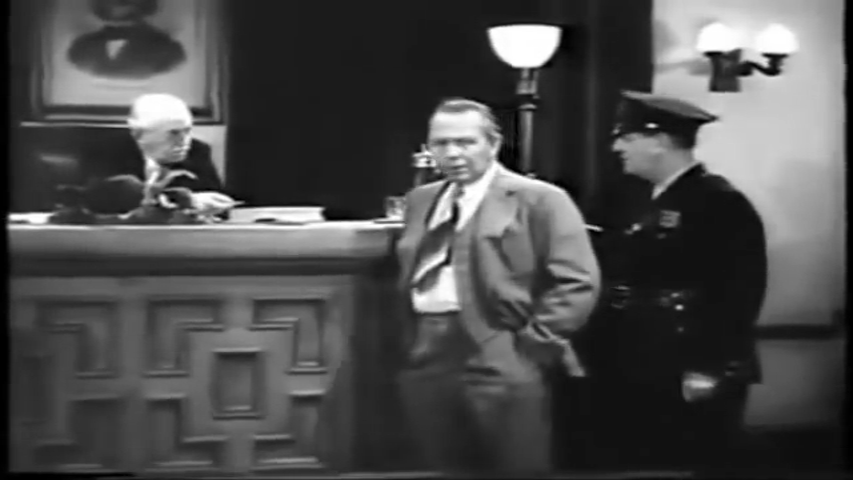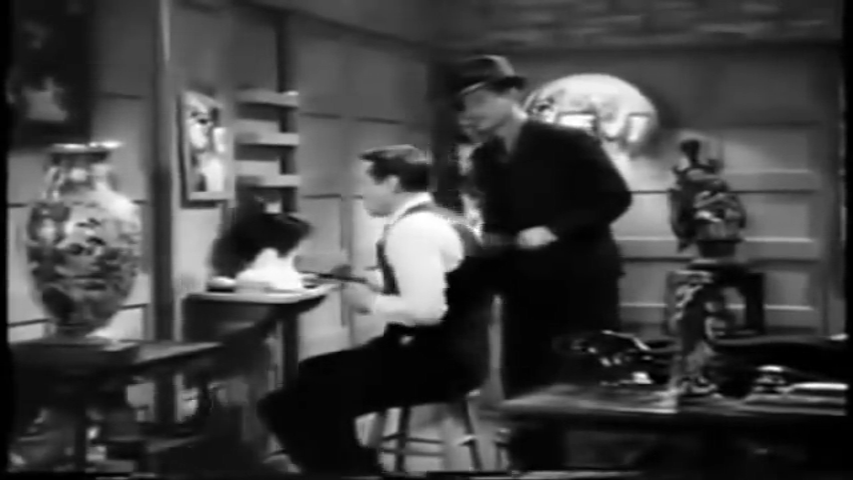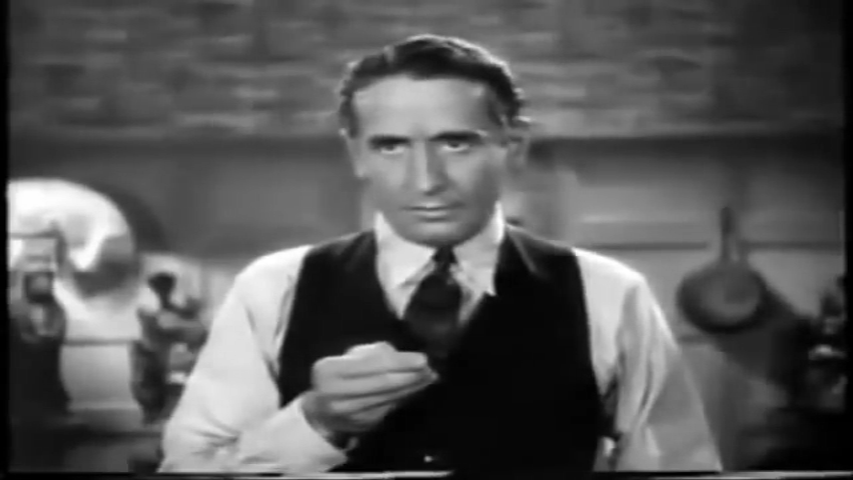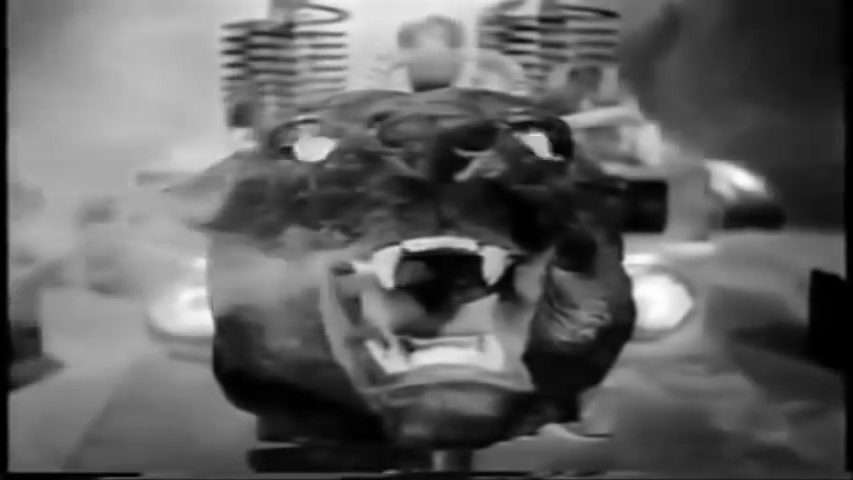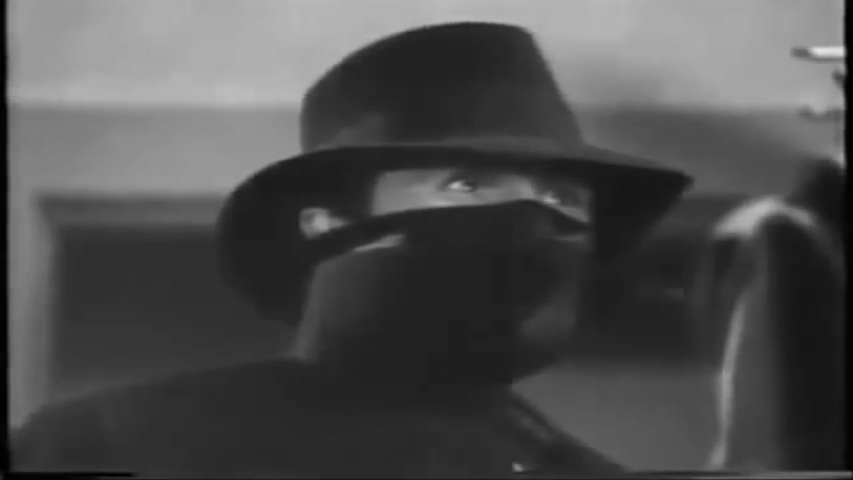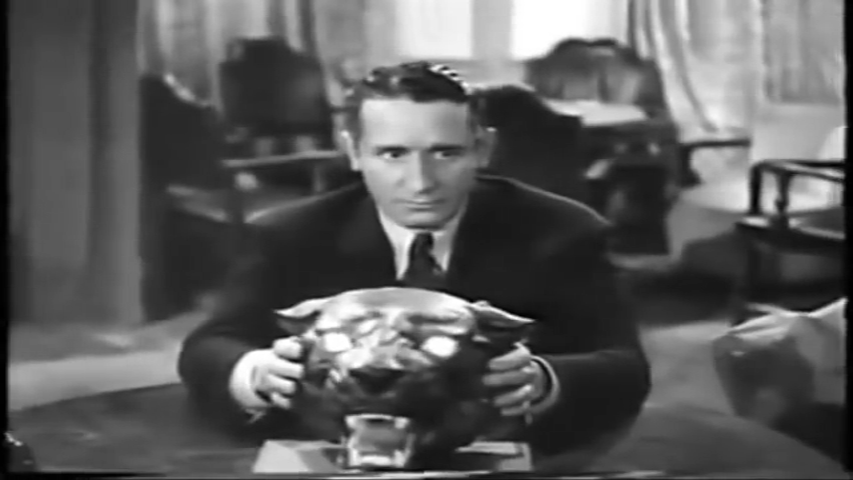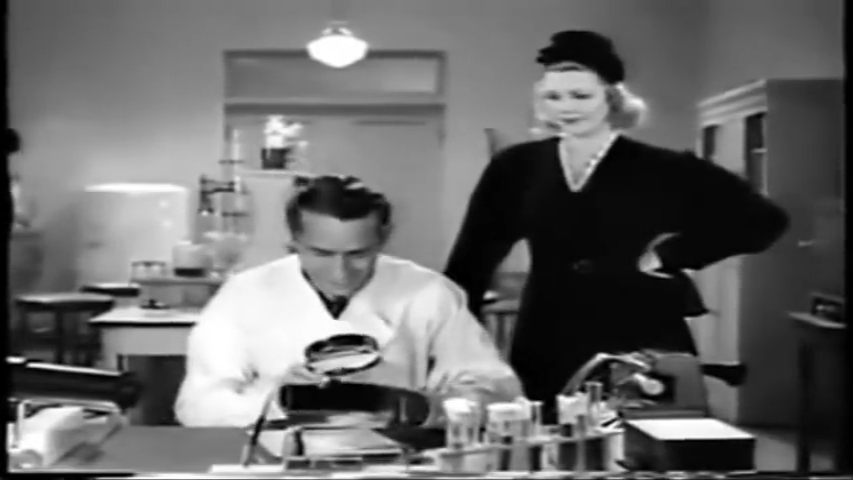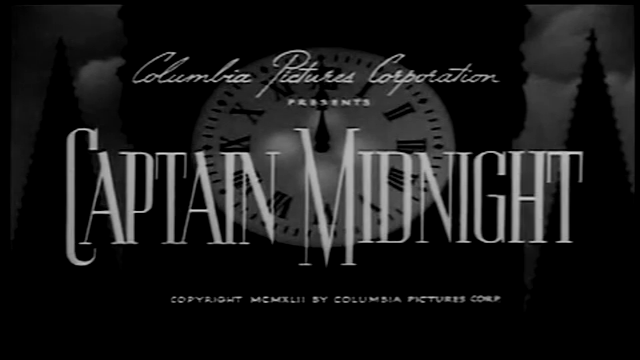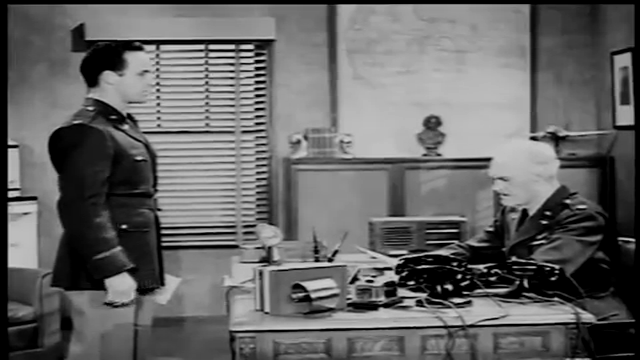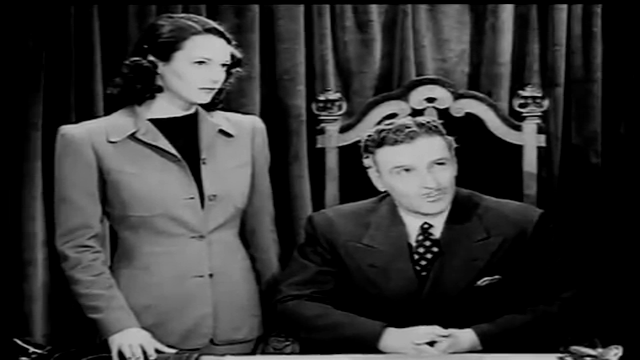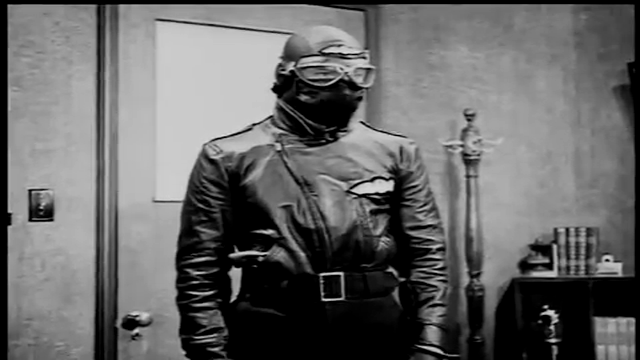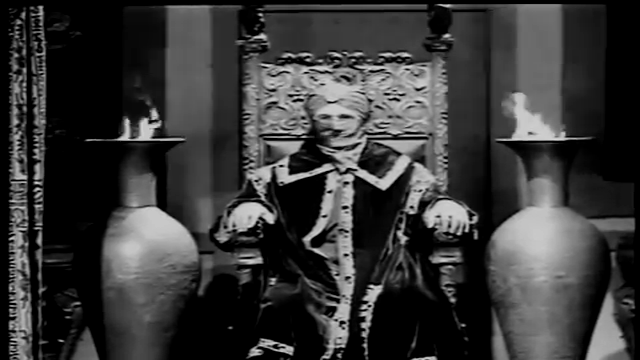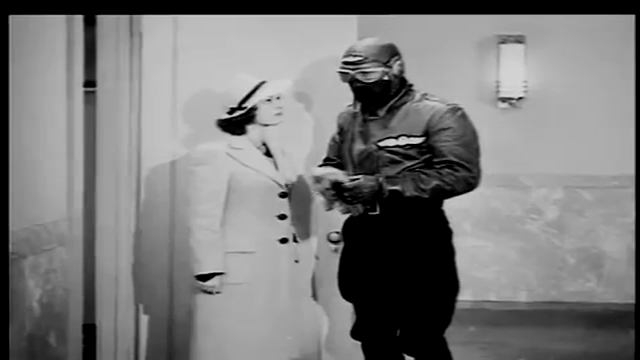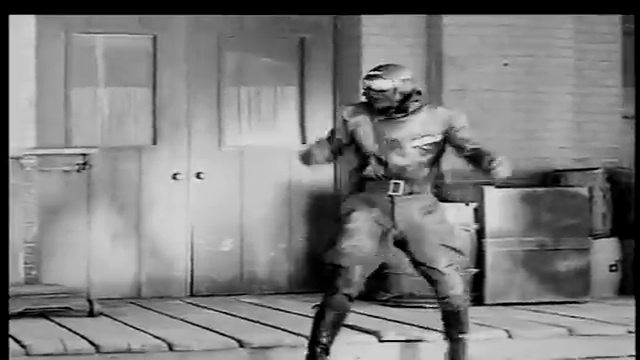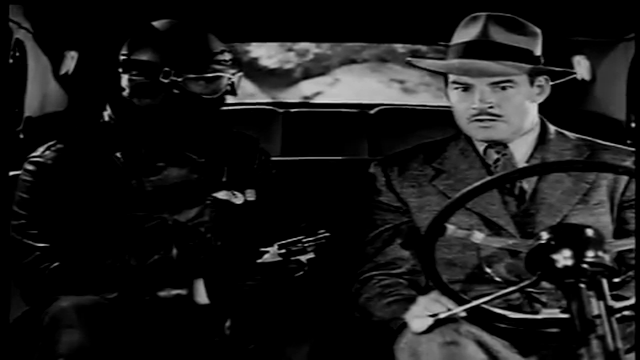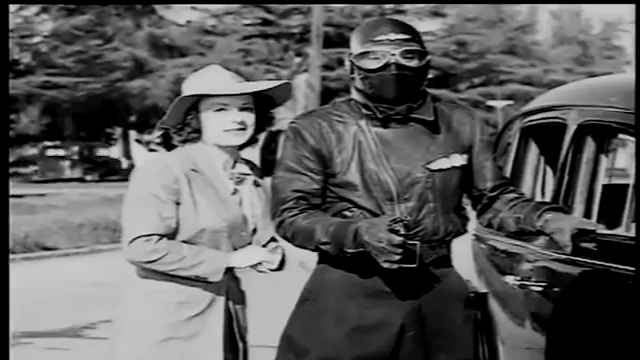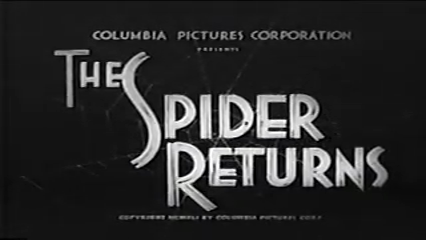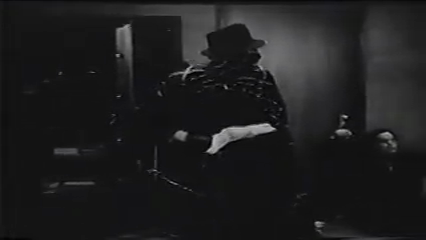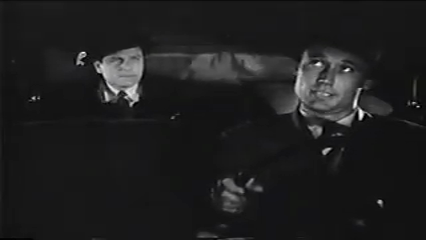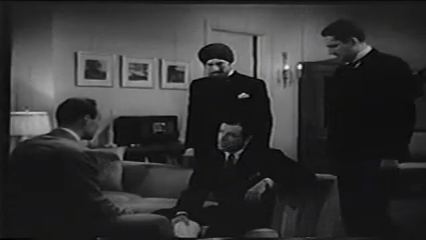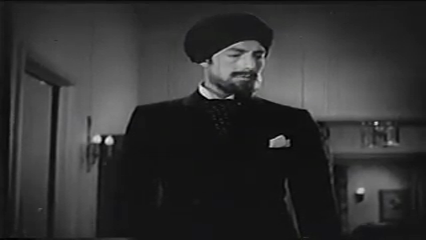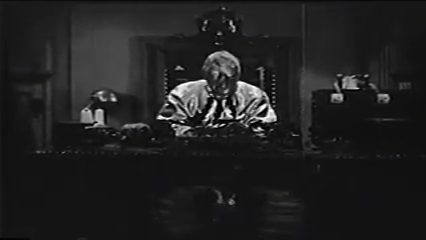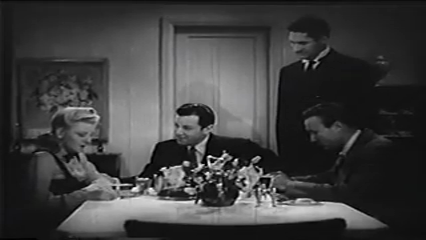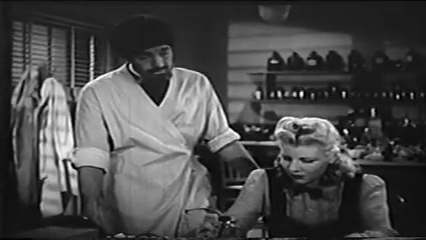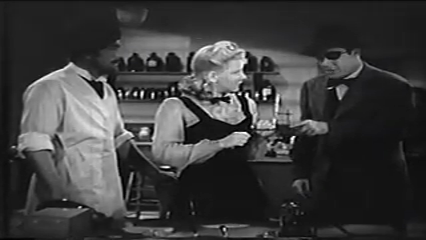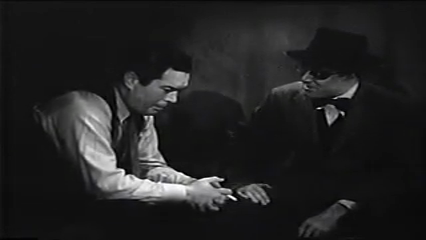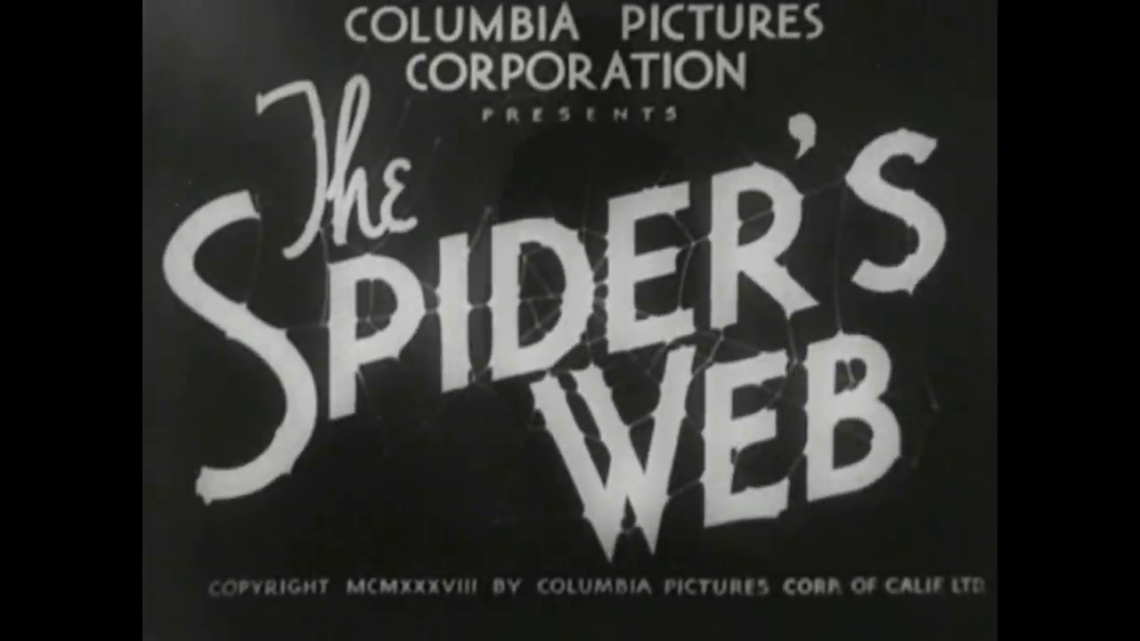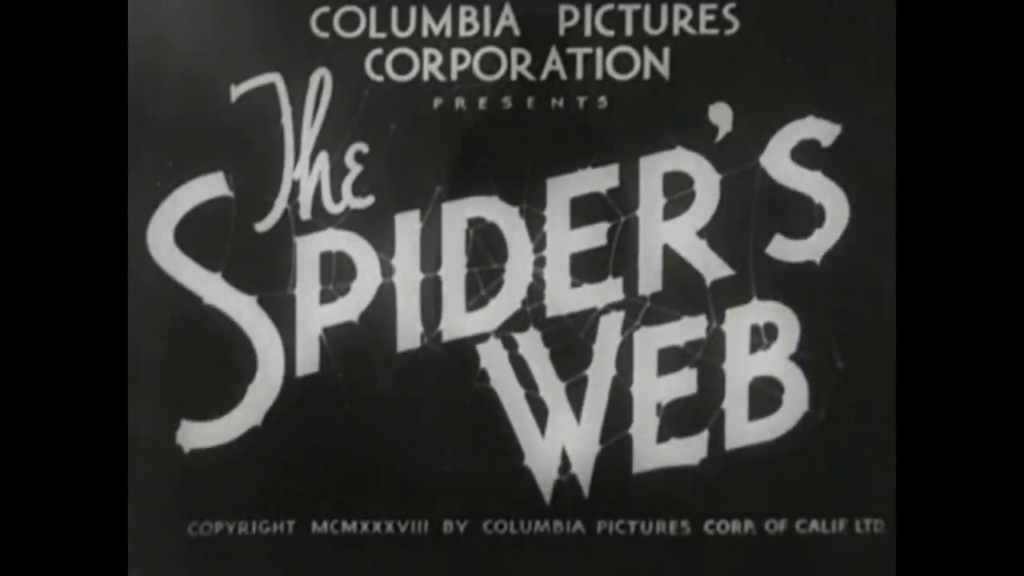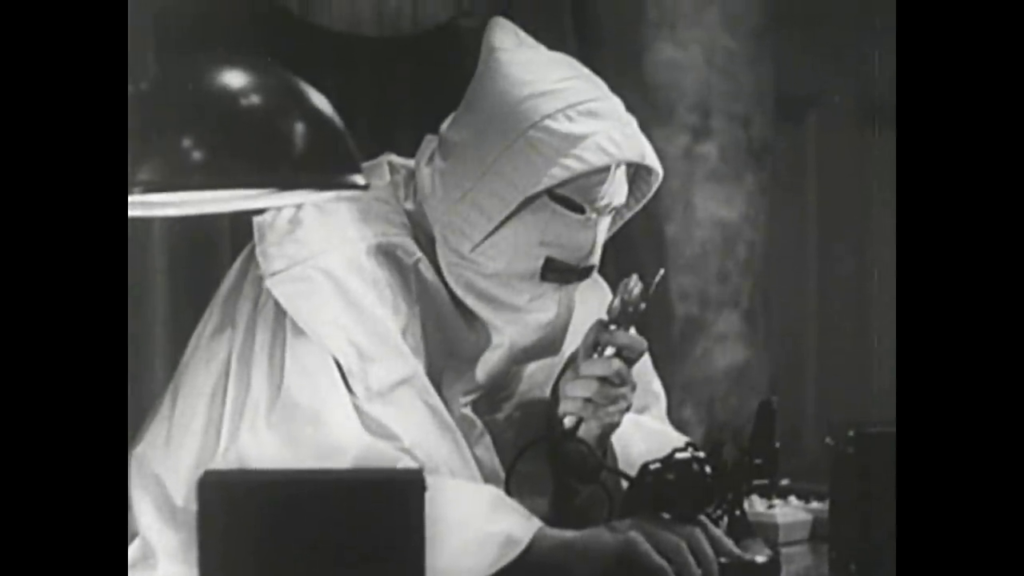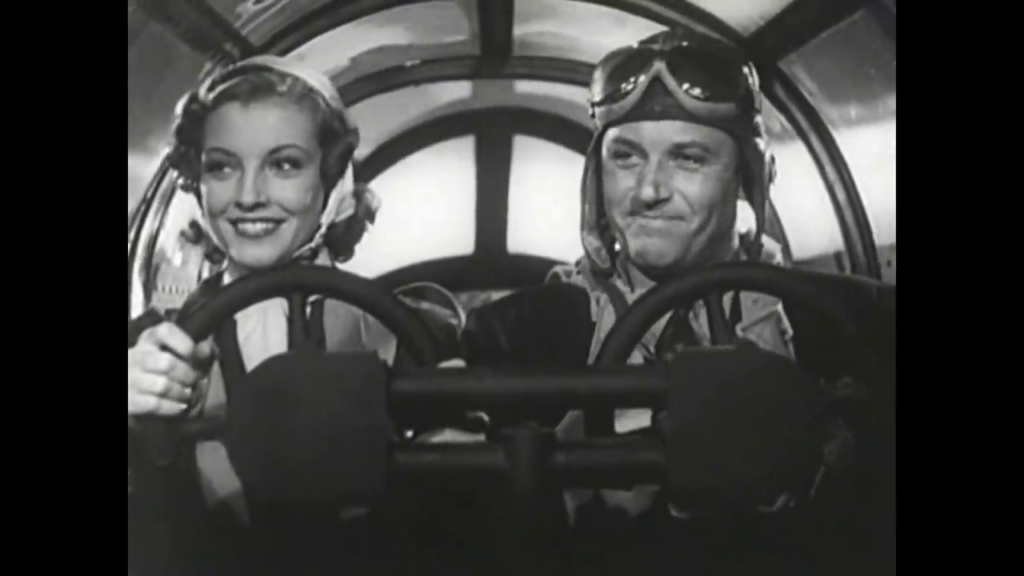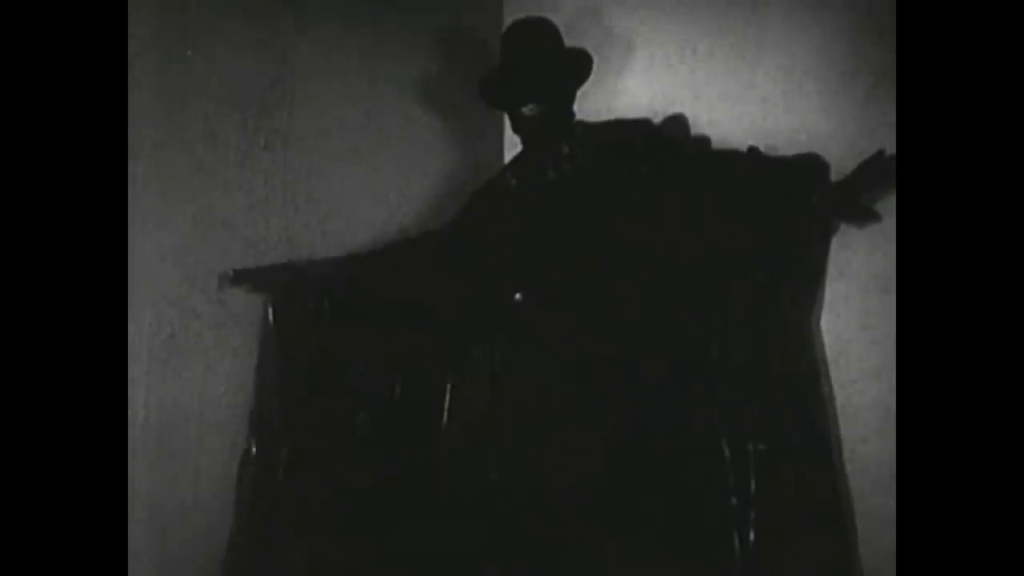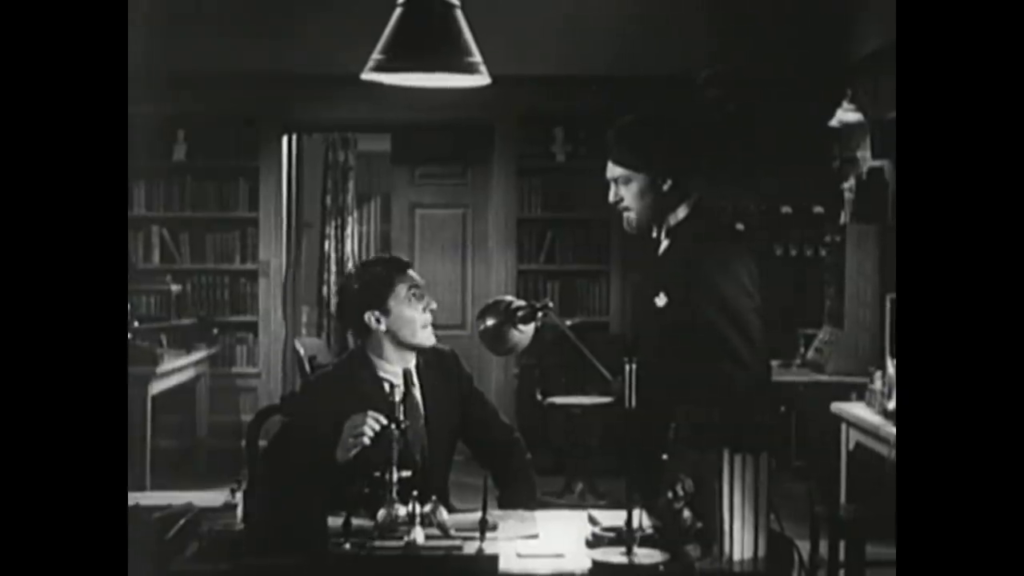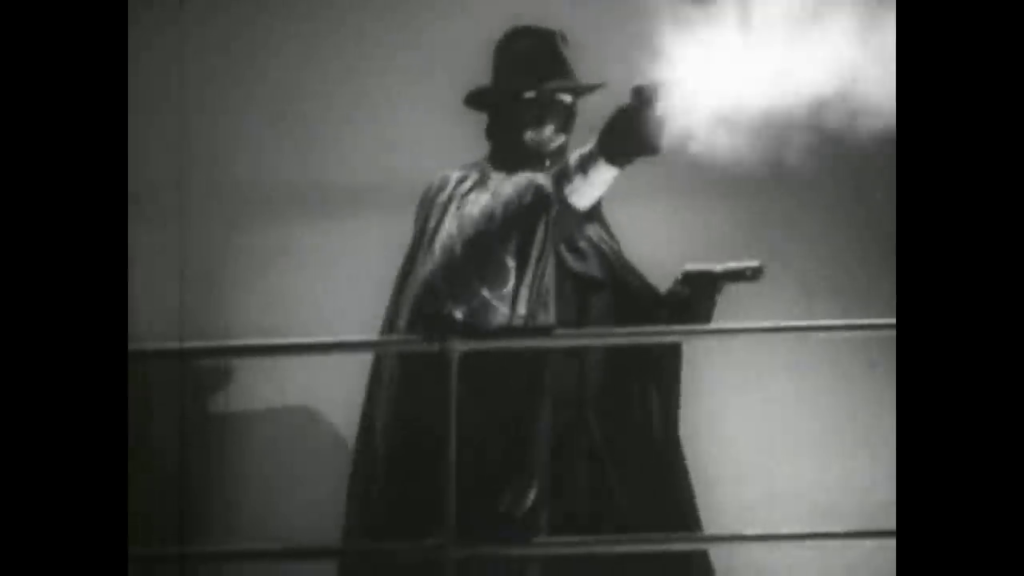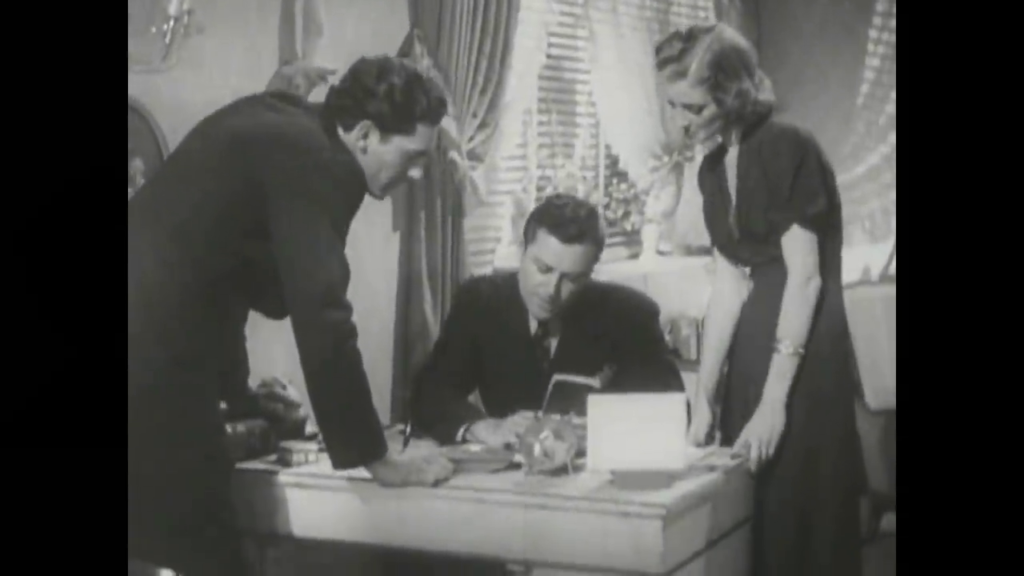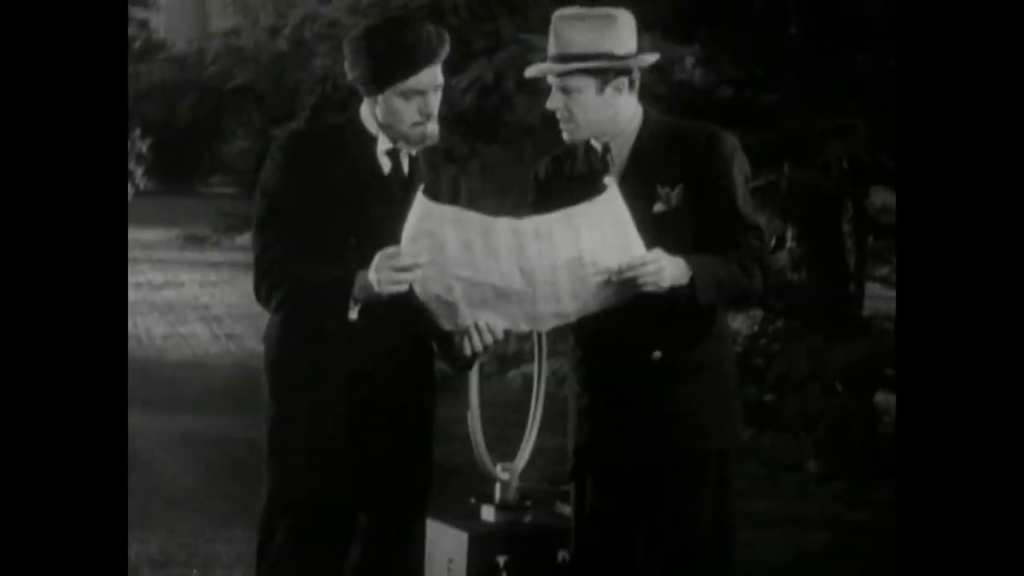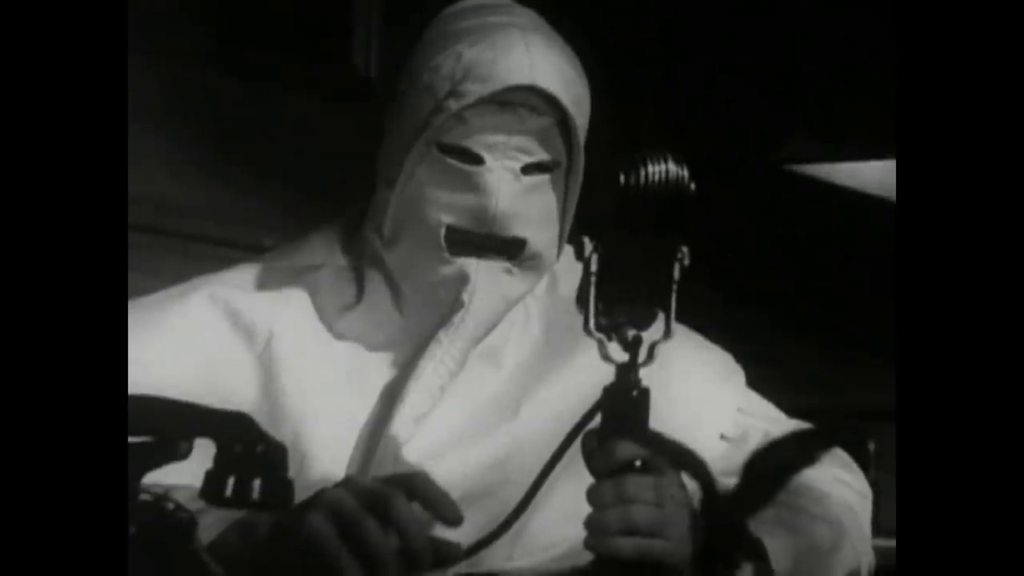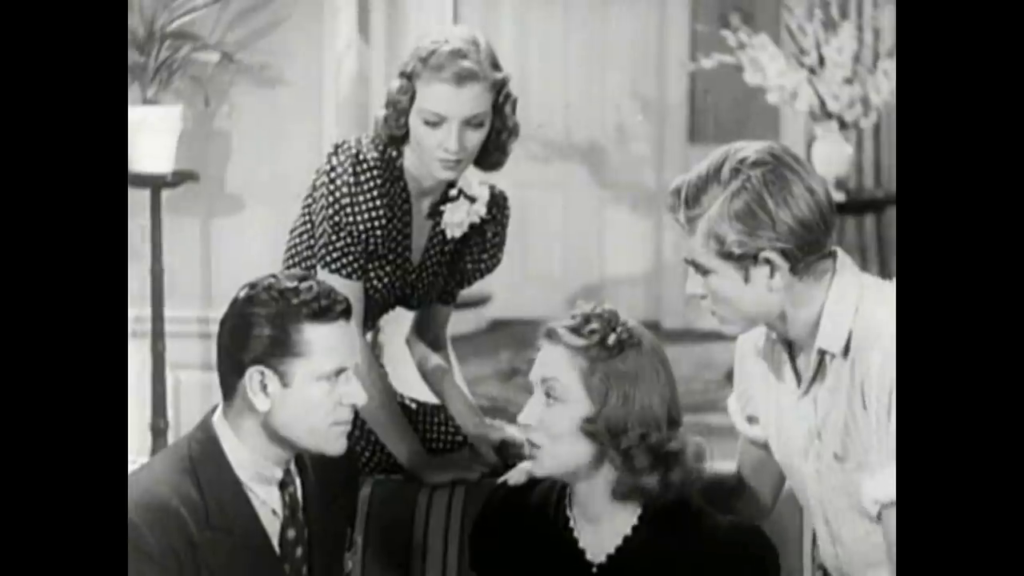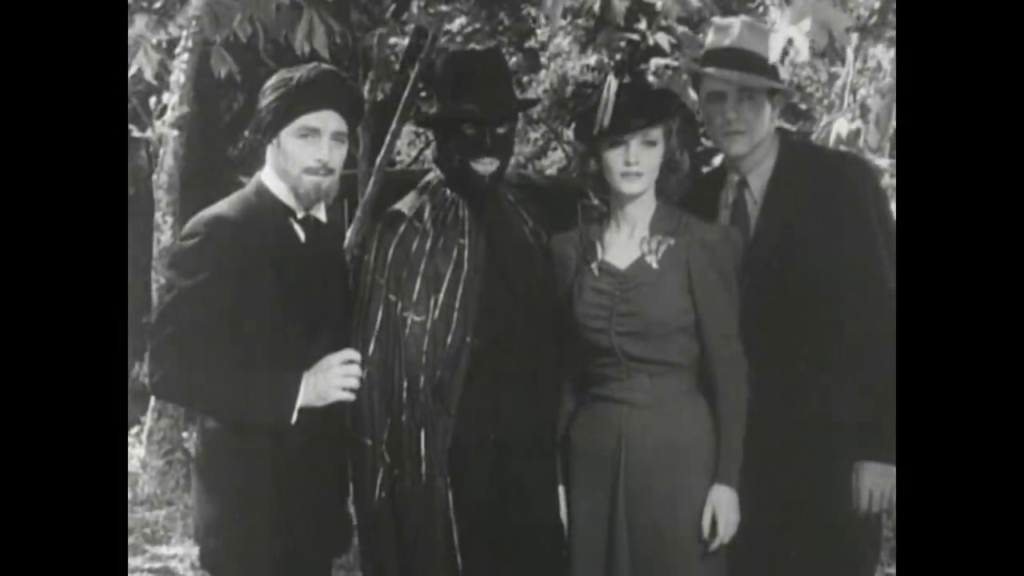-
#445 – The Green Archer (1940)
The Green Archer (1940)
Film review #445
Director: James W. Horne
SYNOPSIS: Garr Castle, home of the Bellamy family, is now owned by Abel Bellamy, after his brother Michael was found guilty of murder. After Abel has Michael killed by attacking the train he was on travelling to prison, Abel uses the mansion as his base of operations for his criminal activities. Spike Holland, an insurance agent and Michael’s friend, works to investigate and bring down Abel’s criminal enterprise, with the help of the sister of Michael’s widow Valerie, her Father, and their butler. They are also aided by “The Green Archer,” the supposed guardian of the Bellamy estate, who fires messages in arrows to warn them of danger…
THOUGHTS/ANALYSIS: The Green Archer is a 1940 serial based on the novel of the same name, and a partial remake of the 1925 silent serial. The serial centres around Garr Castle, an American estate owned by the Bellamy family. Michael Bellamy, the owner of the estate, is framed for murder and on his way to prison when the train he is travelling on is attacked and destroyed, killing him and any others. His brother Abel, who orchestrated the attack, takes over the estate, and turns it into a base for his criminal operations, and kidnapping Michael’s widow. Spike Holland, an insurance investigator and Michael’s friend, seeks revenge for his friend’s death, and prove that Abel was behind it. To complicate matters a man dressed as “The Green Archer,” the supposed guardian of the Bellamy estate, sends Holland messages warning him of plots and danger, whereas one of Bellamy’s men also dresses as the Green Archer, luring Holland into various traps. The plot of the serial is fairly straightforward, as the heroes and villains engage in a back-and-forth of schemes and counter-schemes to outdo one another. The setting of Garr castle where most of the serial takes place sets a stage full of traps and secret passageways that the heroes and villains use, but apart from a few instances, feels rather under-utilised (probably because of budget constraints). The tone of the serial tends towards more comedic than action-based, which is probably the influence of the director, who has done the same on other serials. The cast of incompetent villains who bicker with each other and annoy Abel to no end lead to Abel getting ever more exasperated and desperate, which provides a rare moment of character development, and sets the serial apart from others.
The characters on the protagonist are a standard serial cast: Holland takes the lead in the action scenes and fist fights, accompanied in his investigations by the token female character (although there are two more secondary women in the cast, which is far more than a lot of serials), and her Father, who takes the older, cautious, and advisory role. Most of the interesting characters, as mentioned, are the villains, and a lot of the serial is seen from their perspective. Abel’s villainous schemes end up being undone not merely by Holland, but by his own henchman’s incompetence, which clearly take their toll on him. Again, the comedic bickering between the characters being one of the main focuses of the serial. The Green Archer himself, obviously taking his appearance from the classic conception of Robin Hood, keeps his identity secret until the very end, but I think it’s pretty obvious who it is.
At a length of fifteen chapters, the serial is at the longer limit of the format. Chapters twelve through fourteen are a self-contained story concerning Abel attempting to locate and steal a “synthetic radium formula.” Given that it is self-contained, it means that these chapters could be removed and the serial sold as a twelve-chapter serial to theatres that wanted it slightly shorter. The setting of Garr Castle is lavishly adorned and furnished, but given that it is the only setting for the serial it doesn’t offer much variety. The Green Archer does some things a bit differently, but doesn’t offer anything interesting plot-wise, and the increasingly absurd schemes leave it very much lacking in believability. It’s not the worst serial there is, but is lacking in momentum in terms of the plot being just a bit of a family feud and some minor crimes thrown in.
-
#438 – Flying G-men (1939)
Flying G-Men (1939)
Film review #438
Directors: Ray Taylor, James W. Horne
SYNOPSIS: Three government ‘G-men’ are tasked with taking down a spy ring that are targeting military defences. To do so, one of them also takes on the masked identity of “The Black Falcon” to operate beyond their operative limits to bring the spies to justice. Learning that a man known only as “The Professor” is leading the spies, they suspect the owner of the local airport to be involved somehow, and work to unravel the mystery and prevent the spies from getting their hands on a new experimental aircraft…
THOUGHTS/ANALYSIS: Flying G-men is a 1939 film serial comprised of fifteen chapters. The seral starts out with four government G-men being assigned to protect a new military aircraft. When one of them is killed by a group of spies attempting to steal the aircraft, the three remaining G-men attempt to hunt down the spy ring before they can sabotage any military defences. To do so, one of them disguises themselves as “The Black Falcon,” who operates individually from them beyond the confines of their job to stop the spy ring. The story is composed of many familiar serial tropes; with the villain secretly being a close associate of the protagonists, plenty of fistfights and chases in cars and planes, and a masked identity for the heroes so they can operate beyond the bounds of the law (this trope saw a decline in the wartime serials, probably because seeing heroes operating beyond the law was a bit too rebellious and similar to spy activities). The identity of “The Black Falcon” as being one of the three heroes and kept secret is a lesser used trope, but has been done before, and their actual identity doesn’t really have any impact on the story. The serial does have a very high-action feel, with it maintaining its energy throughout the chapters, and quickly moving from one action sequence to another. There’s a little bit of standing around and explaining the plot, but it’s nowhere near as bad as some other serials. If you were to go to the theatre each week to watch every new chapter, you would at least get to see plenty of action and be reasonably entertained for fifteen minutes.
The three main characters are the usual heroic leads, in that they are the young, athletic men who can throw the punches in fistfights and jump out of cars without any danger to themselves. being three of them, there’s no need for the usual sidekick character that accompanies the hero to help in the action scenes. There’s nothing to really distinguish the three, apart from one of them being The Black Falcon, the identity of which is revealed in the last minute and has no impact on the plot. However, the three do work together well, and co-ordinate together so you get the sense that they do know each other well. Supporting characters include the sole female character and her young brother, who provides the role that younger viewers can relate with. Their characters are nothing special but do have certain chapters that focus on their actions, so that helps give the serial some variety. The villains are altogether rather uninteresting, with “The Professor” being the mastermind of the spy ring, but his motivations are never explored, making him a rather flat character. His identity as one of the G-men’s friends is not fleshed out, and a very typical plot device of the format.
The car chases and airplane fights, while obviously cheaply produced, work decently enough, and there’s enough explosions and shootouts to keep viewers entertained. There’s also a fair amount of locations used in the serial, as the heroes fight their way though multiple enemy bases. There’s enough variety and action that would have kept the viewers going to the theatre to see Flying G-men to be fairly satisfied, even if it doesn’t do anything too special to set itself apart.
-
#428 – The Shadow (1940)
The Shadow (1940)
Film review #428
Director: James W. Horne
SYNOPSIS: A mysterious criminal mastermind known only as The Black Tiger is targeting all of the city’s infrastructure and industries in order to make a fortune. The leaders of these organisations call on Criminal scientist and investigator Lamont Cranston to apprehend the Black Tiger. Unbeknownst to them, Cranston is secretly a masked vigilante who calls himself The Shadow, who takes on the villains without any oversight. The police believe The Shadow and The Black Tiger to be one and the same, and so Cranston must thwart the Black Tiger’s operations in secret while he is also pursued in his alter-ego…
THOUGHTS/ANALYSIS: The Shadow is a 1940 serial composed of fifteen chapters, based on the comics and radio plays of the same name. The plot of the serial follows Lamont Cranston, a criminal investigator/scientist who is tasked with stopping a criminal mastermind known only as The Black Tiger, who is launching attacks on the companies and industries of the city in order to amass a fortune. The plot of the serial is pretty weak: each chapter focuses on a different company or industry that is under attack and Cranston/The Shadow must protect (the target of next week’s chapter is shown in the trailer at the end of each chapter). The structure is quite similar to The Green Hornet, which also focused on various industries under attack by a criminal, and the lead also playing a masked vigilante who is also wanted by the police. There’s no overarching plot or evil plan by the villain other than to just get rich. There’s nothing wrong with villains just being villains, but if there’s nothing to tie the fifteen chapters together in terms of story and consequence, then viewers aren’t going to come back week after week to see how the story continues. Many serials have the same problem, but usually there’s an overarching objective to the serial, such as sabotaging American infrastructure to pave the way for foreign invasion (particularly in the wartime serials of the 40s), but The Shadow is especially weak in this regard.
Lamont Cranston, the serial’s lead protagonist, is a little different from the usual good looking, All-American hero. Victory Jory, who plays Cranston, was typically cast as villains, and his appearance lends itself to that. here though, while being the protagonist, he is also the masked vigilante The Shadow, whose appearance is meant to be more villainous. In his disguise, only the top half of his face is visible, and Jory’s piercing stare definitely has a nefarious look. His iconic laugh, known from the radio series, announces his arrival and definitely strikes fear into his enemies. On top of this, Cranston also has another disguise as a Chinese businessman and petty criminal, which he uses to get information from other criminals. The major problem here is that Jory is white, and using makeup to magically “become Chinese” by squinting his eyes, putting in a set of big false teeth and a fake accent is undoubtedly racist, as if everyone can suddenly no longer tell he is white. It is not uncommon for white actors to portray Asian characters in this era (and for some time after), but the racist caricature he adopts here goes beyond the usual makeup jobs and is wildly unacceptable. The character is very similar to the protagonist’s alter-ego Blinky McQuaid in The Green Hornet, who also provided a disguise of a petty criminal for undercover work. All of these different alter-egos and settings in The Shadow just come across as confusing and dilute the story somewhat. The Black Tiger, as mentioned, doesn’t have much in the way of motivation or character: he is suspected of being one of the company directors who are under attack, but the mystery of his identity is a familiar plot device to those who watch these serials. His ability to turn invisible when he enters the hideout to address his henchman is somewhat impressive, but it begs the question that if he can turn invisible, why doesn’t he use these powers to commit crimes himself? The extent of this power is never explained or explored, and makes very little sense. The rest of the cast are so unremarkable and standards of the serial format that they’re not even worth commenting on.
The cliffhangers for this serial at the end of each chapter are standard stuff, but there’s quite a lot of destruction in them, as roofs collapse on top of our hero and such. Whether he is caught in an explosion, trapped under debris or crashes off a cliffside, the cliffhangers always end the same way with The Shadow just walking away from all of these incidents which should have killed him. Given that he doesn’t have any superpowers, the resolutions are always a letdown and frankly inexplicable. However, the Columbia Pictures serials often had cliffhangers end this way with the hero simply walking away from certain death with no explanation. Since we never see The Black Tiger, all of his orders come from tiger heads which have light-up eyes whenever he speaks, which are pretty cool effects for the time. The settings aren’t anything too special, and I feel like there should have been more scenes of The Shadow actually in the shadows, rather than the mostly brightly-lit settings we got. The Shadow is not the worst serial I have seen, but it has some major flaws; from the lack of substance in the plot to the racist caricatures, there’s plenty of reasons to give it a miss. The Shadow is a decent masked vigilante with the iconic laugh that viewers would have wanted to hear on the screen, but otherwise there’s not much to see or anything memorable about it. You’re better off watching The Green Hornet, which is practically identical in terms of story and characters, but executed much better. -
#422 – Captain Midnight (1942)
Captain Midnight (1942)
Film review #422
Director: James W. Horne
SYNOPSIS: Professor Edwards has invented a new type of radar that will surely help the U.S. government in the war effort. However, a foreign power has employed criminal mastermind Ivan Shark to steal the device for their own use. Ace pilot Captain Allbright uses his secret identity of Captain Midnight to try to stop Shark and his men before the device falls into their hands, and to stop Shark’s bombing of American cities using his own aircraft…
THOUGHTS/ANALYSIS: Captain Midnight is a 1942 movie serial based on the radio plays of the same name. The plot is fairly straightforward and very familiar if you’ve ever seen a movie serial from this era: Ace pilot Captain Allbright uses his masked alter-ego Captain Midnight to stop a criminal from stealing a new weapon and selling it to an enemy government. It’s the same plot used through many wartime serials that would have had contemporary relevance. Unfortunately, there isn’t much content to separate it from the rest of similar serials, as there are plenty that use masked alter-ego’s, and also lots that centre around the use of planes. While using the characters from the popular radio play would have brought in extra viewers, there isn’t much uniqueness that viewers will get from the serial. The villain’s plots of stealing a new invention and bombing American cities are a bit interchangeable, and the serial moves back and forth without any real continuation or progression of the plot, resulting in very little development over the course of the fifteen chapters. Like every other serial, each chapter ends in a cliffhanger in which Captain Midnight faces certain doom only for it to be quickly resolved at the beginning of the next chapter. While these resolutions are usually anti-climactic, the serials produced by Columbia Pictures often have the least creative solutions, with Captain Midnight mostly just escaping car crashes or explosions by just walking from them a little dazed. In one such cliffhanger, he just walks away from a plane crash and jumps into a fistfight, which is quite ludicrous even by the serial’s standards.
Captain Allbright/Midnight is the typical serial hero: the square-jawed all-American hero who gets into plenty of fights and daredevil escapes. There doesn’t seem to be much point in his alter-ego: everyone seemingly knows who he is, and it wouldn’t matter if he was exposed or not. His “Secret Squadron” who aid him in his heroic deeds don’t really have a part to play, and what little we see of them shows they only fill very typical roles of sidekicks. Major Steele, Midnight’s government contact, is the authority figure who gives the orders and who Midnight plans with to catch the villains. The main villain himself, Ivan Shark, has a distinguishing trait in that he is a master of disguise, and subsequently disguises himself as a number of the serial’s characters over the course of the fifteen chapters; including Captain Midnight himself. His disguises also come with dubbed voice-overs of the characters he is playing, which is very obvious. It’s a trait that was used by the protagonist in The Spider serials, and definitely used to better effect there. Shark’s daughter Fury (that is her name apparently) has a role as second-in-command, but doesn’t really play much of a part. At the start of the serial, she seems reluctant to follow some of her Father’s schemes, leading me to believe she may be a character that swaps sides and questions her loyalties, but that is perhaps too complex for this serial, as this trait is soon forgotten and quickly becomes just another flat villain giving orders.
The main problem with Captain Midnight is that it’s story goes nowhere. There’s no build-up, and the focus keeps shifting so it feels like nothing of consequence is happening, which means it is going to be difficult to keep viewer’s attention over the course of fifteen chapters (or four and a half hours). Some of the stunts are decent, but nothing too outstanding, and there’s not enough plane-based scenes that you might expect from the titular character. The villain’s motivations are confused and all over the place, which further confounds any attempt to advance the plot. Although it doesn’t stray from the typical serial formula, there’s definitely better examples of the format you can watch.
-
#412 – The Spider Returns (1941)
The Spider Returns (1941)
Film review #412
Director: James W. Horne
SYNOPSIS: A masked criminal, known only as The Gargoyle, and backed by malicious foreign powers, aims to sabotage national defence production by targeting the owners of key industries. Criminologist Richard Wentworth must once again don the secret disguise of “The Spider,” a masked vigilante, in order to move outside of the rules and regulations of law enforcement, and along with his friends stop The Gargoyle before he can do irreparable damage to the country…
THOUGHTS/ANALYSIS: The Spider Returns is a 1941 movie serial and the sequel to the 1938 serial The Spider’s Web, based on the magazine comics of “The Spider.” The serial follows a similar setup to the first one, with criminologist Richard Wentworth secretly disguises himself as the masked vigilante The Spider in order to stop another masked individual known only as The Gargoyle, whose criminal gang is working to sabotage industries related to national defence. Sabotage really is the key word for the plot of this serial: it was released in 1941 in the context of the second world war and a heavy focus on the U.S. gearing up for getting fully involved. The concept of sabotage runs through a lot of wartime serials, with suspicion being placed on “the enemy within,” who would attack not from outside, but from the inside through the acts of sabotage. There’s a fair amount of wartime messaging throughout the serial, explaining how “our great country” is under threat from “foreign powers,” who will target key industries. No specific country names are mentioned, but you can figure it out. With this theme, the serial has a bit more of a darker tone to the story, but never anything overly scary, as these serials are generally aimed at younger audiences and bringing in families. To seemingly offset the darker tone, there’s some more silly moments, usually between The Gargoyle and his inventor assistant, as The Gargoyle berates him for his inventions going wrong. They do however make The Gargoyle feel a bit less threatening, but again that may have been the purpose to make the serial a bit more family-friendly, and the villain less scary, while still getting the wartime message through. Overall though, it does present a bit of a mismatch that makes the comedy seem on the whole out of place.
All of the protagonists from the first serial make a return here, although only two of the original actors reprise their roles: Warren Hull as Richard Wentworth AKA The Spider, and Kenne Duncan as Wentworth’s chauffeur Ram Singh. Dave O’Brien, who was Hull’s stunt double in the first serial, now takes over as Jackson, Wentworth’s assistant. The characters more or less have the same roles as they did before, but perhaps have less to do than they did in the first serial, which balanced out the use of the characters a lot more than most serials. Hull performs the triple role of Wentworth, The Spider, and Wentworth’s disguise Blinky McQuaid, a petty criminal who Wentworth disguises himself as in order to go undercover and get information from The Gargoyle’s henchman, and his multi-faceted role is very much the centrepiece of the story. The different roles give enough variety to the situations, and causes Wentworth to consider his actions in terms of how each character is perceived, such as police commissioner Kirk’s attempts to catch The Spider, and who always has suspicions that Wentworth is the masked vigilante. As mentioned, the villains are a bit less threatening in their hapless endeavours, as The Gargoyle gets into some comedic banter with his inventor assistant, and using his X-Ray eye machine, spies on his underlings to see they are having a party instead of doing his evil work.
While The Spider’s Web was a wildly popular serial that probably (in part) sparked the trend of masked superhero serials, The Spider Returns isn’t quite as good as its predecessor, but is still a decent example of the format, with enough variety through Hull’s triple performance, the sci-fi inventions used by the villain, and the focus on sabotage and its wartime message has some impact. The trend of masked superheroes faded away after the war was over, instead making the leads more military-like and ordinary to reflect the victorious soldiers of the war. However I think the escapades of The Spider shouldn’t be forgotten, as they were very influential in the production of the serial format in its time.
-
#411 – The Spider’s Web (1938)
The Spider’s Web (1938)
Film review #411
Directors: James W. Horne, Ray Taylor
SYNOPSIS: A wave of crime across the city targeting key infrastructure and transportation networks is being conducted by a criminal mastermind known only as “The Octopus” with aims to take over all the key utilities and companies. Criminologist Richard Wentworth must don his secret identity of “The Spider” in order to thwart The Octopus’ plans outside of the police’s rules and regulations…
THOUGHTS/ANALYSIS: The Spider’s Web is a 1938 serial based on the comic book character “The Spider” (not to be confused with spider-man). The serial starts out strongly as most of the format does in order to entice viewers back week after week. In the opening chapter contains plane crashes, car chases, fist fights and a heap of explosions, so there’s definitely plenty of bang for your buck. The explosions and destruction of key transport and city infrastructure is being carried out by a criminal mastermind known only as “The Octopus,” who seeks to put his own men in charge of all these utilities by killing off the current managers of them. Renowned criminologist Richard Wentworth is travelling home on his plane with his sweetheart Nita van Sloan when their plane is attacked and they have to parachute out. Wentworth learns of this new crime wave and decides to once again become the masked vigilante “The Spider,” who chases crime where the rules and regulations of the police cannot go, even though he promised Nita that he had retired from the costumed life. The story is a standard serial affair of the hero foiling the villain’s various schemes across the fifteen chapters, and while it does not do much unique in terms of story, it still executes the usual plot points in a fun and interesting way, and with a good level of competency.
The characters are a typical cast of serial characters. Wentworth is the usual lead character, Nita is the sole female character, and Jackson is the sidekick who gets in on some of the action. Ram Singh is Wentworth’s assistant who is clearly meant to be Indian, but is portrayed by a white American and refers to him as “Master” occasionally like he is a servant. and that is obviously a problematic stereotype of non-white people being subservient to them. Wentworth himself is very much like Batman’s alter-ego Bruce Wayne: he is rich, clever, works alongside the police, but when he dons his mask to fight crime, he is wanted by them. He can also disguise himself as a known criminal “Blinky” McQuaid, which he uses to get close to the criminals and get the information on their plans. These different facets to the main character add some good variety to the serial, and make the lead a bit more stand-out from the sheer volume of serial leads which all look and act the same. The Octopus as a villain is shown to be cunning and ruthless, as he executes those who fail him. His being dressed in a white hood and cloak mirrors the Spider’s outfit, which is almost the same, but in black. The identity of The Octopus is, unusually for such a serial, never really explored or even revealed in the finale, and we are only told he is one of the most powerful men in the city.
At the time of it’s release, The Spider’s Web was a huge success, and it is easy to see why: it doesn’t deviate from the serial format, but does all its tropes pretty well. The character of The Spider as a masked vigilante probably helped kick-start the popularity of masked superheroes, and serial adaptations in the 1940s. The Green Hornet, one such serial, is practically identical in both story and characters, with the masked vigilante stopping crime and eluding the police, while being aided by a foreign sidekick.
